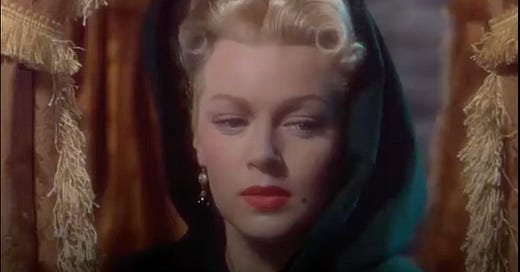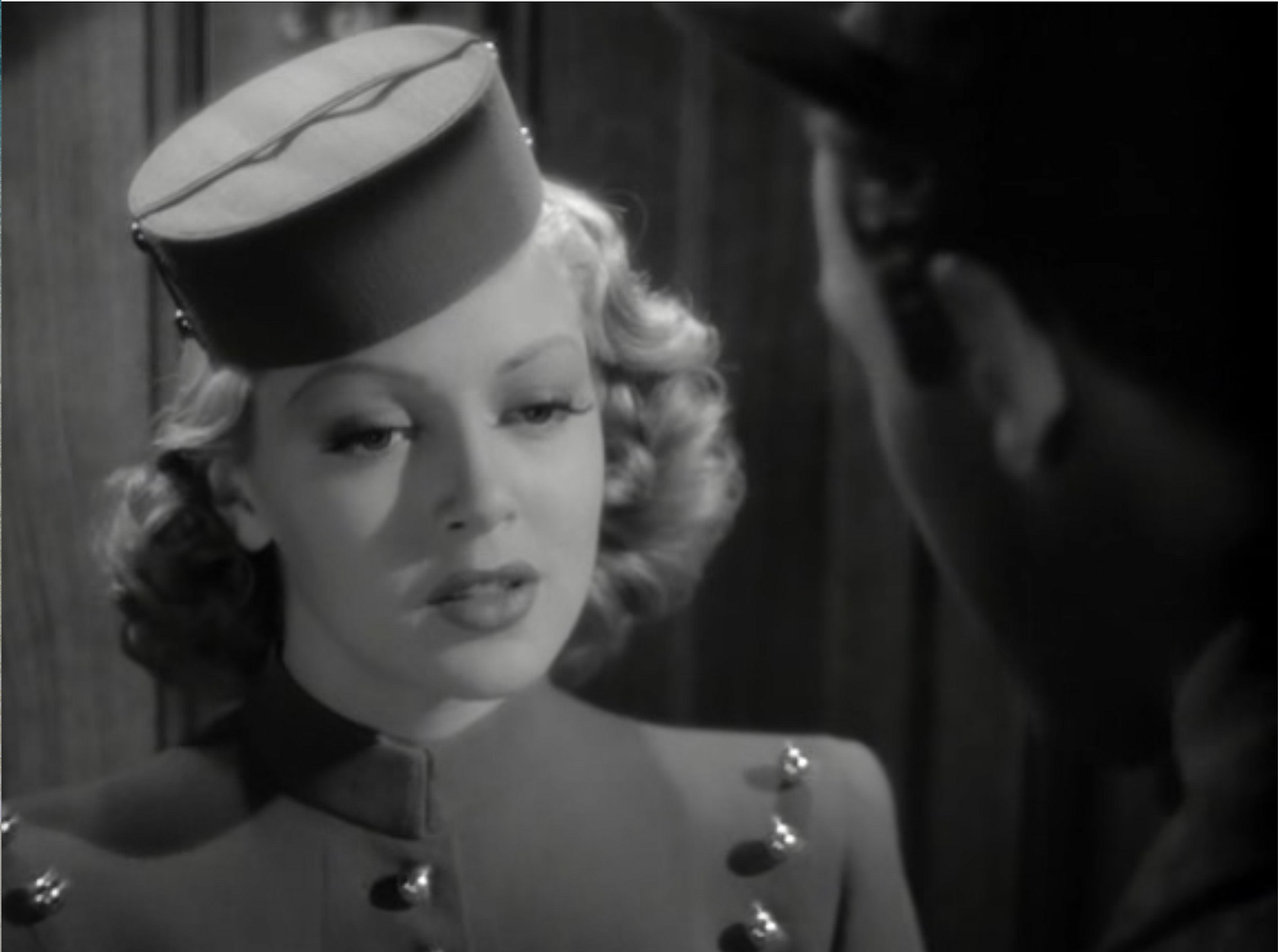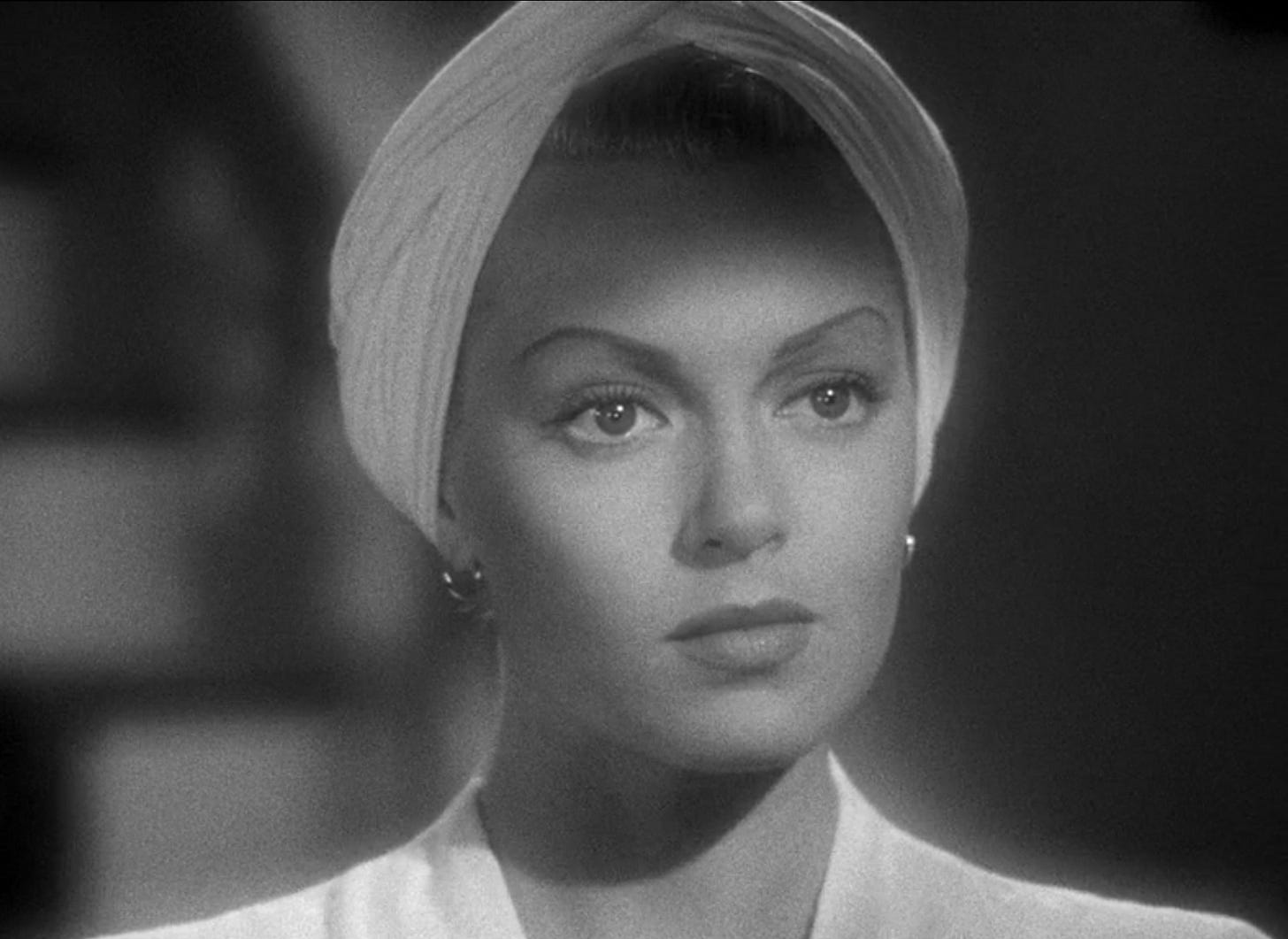In three major films, The Postman Always Rings Twice (1946), The Bad and the Beautiful (1952), and Imitation of Life (1959), Lana Turner proved that she was more than just a classic Hollywood exemplar of what hype and glamour can do. Her name became synonymous with scandal and danger and, to her devoted fans, naïve romanticism, but the real woman behind the image seems to have been funnier or more fun-loving than the way she came across on screen, as can be seen in an affectionate and compassionate coffee table book from 2008 by her daughter Cheryl Crane. There is not one bad or unflattering photograph in that massive book, and if anything Turner looked even better without make-up and elaborate clothes and jewels, right up to the end.
She was born Julia Turner in Idaho in 1921, and her parents liked to move around. In 1930, her father was found bludgeoned to death after he won a craps game; his winnings were missing, and his murder went unsolved. Turner’s mother had trouble earning enough money for them, and there was a time when the young girl was farmed out to a family who treated her cruelly. Things only began to change when her mother had respiratory trouble and took them to a drier climate in Los Angeles.
The classic “discovery” story went as follows: Turner had barely started attending Hollywood High School when she skipped a typing class to get herself a Coca-Cola at the Top Hat Malt Shop. Hollywood Reporter publisher William R. Wilkerson was impressed with the looks of the young beauty, and he formally asked through an intermediary at the cafe if he could speak to her. When asked if she wanted to be in pictures, Turner supposedly replied, “I’ll have to ask my mother first.”
Painfully shy at 15, Turner was eventually brought to director Mervyn LeRoy, who needed an attractive young girl to play the murder victim in his socially conscious drama They Won’t Forget (1937). When she entered the room, he said, “Walk” because he wanted to see how she might move across the screen. Attending the movie’s premiere with her mother, Turner was mortified to see herself bouncing across a sidewalk in a tight sweater, especially because men in the audience let out wolf whistles.
Turner was signed to MGM when LeRoy went over to that studio, and she spent 18 years at this grandest of dream factories and made them 50 million dollars with her films. She was “built” as a star slowly and carefully, and Turner danced surprisingly well in early musical roles and was much livelier when she had her natural reddish hair.
It was in Ziegfeld Girl (1941) that she ascended to another level, lightening her hair to make it blonder and going through the motions of self-destruction as a chorus girl who becomes a drunk and takes a dramatic fall down a staircase. Turner vacillates in that movie between hard cunning and baby-ish vulnerability, a combination that excited certain men. In her early film vehicles at MGM, she is like a cream puff or cotton candy, all calories, no nutrients.
But she rose to the occasion and then some in The Postman Always Rings Twice opposite John Garfield, who takes a heated breath when he first sees her dressed in a white turban, white top with bare mid-riff, white shorts, and white open-toed shoes. Her Cora wants a business to run above all, and she wants respect; love or sex play second fiddle for her. “I wanna be somebody,” Turner’s Cora says, even as she and Garfield make the case that sexual chemistry can be like nuclear power. Postman was made at the height of censorship restrictions on American movies, yet no censor can block who Turner and Garfield seem to be on screen and what they seem to want to do with each other.
Turner’s Cora is the proud prom queen, the prize, and she won’t settle for anything less than her due, and Turner is very convincing as the sort of person who might sink very low to get what she wants. She got little help from her director Tay Garnett, who had a drinking problem, but she is buoyed by Garfield and manages to be as tough as he is when crossed, and this toughness is startling given the limitations of her earlier work.
Turner’s performance in The Postman Always Rings Twice is unerring in its psychological accuracy. Her Cora is a very smooth liar when she just jumps right into the lies, but when she has to repeat lies that have been practiced, she gets too self-conscious to be wholly convincing. Look at the way she stands after the murder of her husband Nick (Cecil Kellaway), with her legs twisted so that her sexuality is utterly out of reach, the exact opposite of the way Jessica Lange plays this scene in the sexually explicit 1981 remake. Turner’s Cora is interested in her business above all, not sex, and she is the ultimate ruthless striver and capitalist. She also has her sadistic side; look at the thrilled expression on Turner’s face when Garfield roughs up a potential blackmailer, a glimpse of Cora’s dark side that is all the more unsettling for going by in a flash.
Turner was gorgeously revealed in Technicolor as the wicked Milady de Winter in The Three Musketeers (1948), and she was at her best again in The Bad and the Beautiful as Georgia Lorrison, an alcoholic daughter of a famous actor who becomes a movie star due to the help of producer Jonathan Shields (Kirk Douglas). “I was a nothing,” Georgia says on the soundtrack, and when we see her screen test, Georgia acts about as well as Turner does in her lesser films and hears from producers that she is “wooden, gauche, artificial.” Producer Walter Pidgeon is told that Georgia comes cheap, and he says, “For nothing you get nothing, she’s nothing.” Surely there were times when Turner was made to feel this way by the men in charge in her early days.
But the shock of The Bad and the Beautiful comes in the famous scene after Georgia is shouted out of Jonathan’s house and has a hysterical meltdown as she drives her car and loses control of it. Director Vincente Minnelli is helping Turner here with his camera movements and lights flashing from other cars to build a sense of panic, but it is Turner who has to deliver this total loss of emotional control, and nothing in her previous work would suggest that she would be capable of it. Turner was told by the notedly inarticulate Minnelli what he might need, and she dug deep down into herself and unearthed this going to pieces with tears and screams in one take. It’s an open question just how Turner managed to do this with almost no help; it’s difficult to imagine fellow love goddesses like Ava Gardner or Rita Hayworth pulling off a scene as extreme as this.
Lily Tomlin has eulogized the classic camp moment at the end of Flame and the Flesh (1954) where Turner’s dark-haired bad girl decides to mend her ways and fluffs her hair to show she is going to be virtuous-ish from now on. When Turner finally left MGM, she got an Oscar nomination for playing a prudish mother in Peyton Place (1957), the sort of casting very against type that gets noticed by the Academy because it is so very noticeable. “I’ve always been so afraid of scandal,” says her Constance.
Turner’s short attention span with the men in her life finally led her into disaster. One of her many husbands, Lex Barker, sexually abused her young daughter Cheryl, and when Turner was told she got a gun and considered shooting him until thinking better of it and ordering him out of her house. But then gangster Johnny Stompanato attached himself to Turner, and he proved impossible to shake off. On a night in April of 1958, Stompanato beat Turner and made threats to disfigure her, and Cheryl was alarmed enough to get a knife from the kitchen in order to defend her mother. When the door to her bedroom opened, Turner fled and Stompanato ran out in a rage with his hand up to hit her some more, and he ran right into Cheryl and right into the knife. He died soon afterward.
The trial led to headlines and melodrama all around, with a frightened Turner taking the stand to defend her daughter, who was acquitted. They did not speak of this ordeal much afterward, but by 1986, Turner said to her daughter, “Cheryl, have I never told you how you saved my life? Gran’s life? {This was Turner’s mother}. Your own life? How if it wasn’t for you, I wouldn’t be here today? Didn’t I ever tell you how grateful I was?” They had their difficulties, but Turner and her daughter Cheryl came through and survived.
Turner believed her career was likely over after the Stompanato trial, but producer Ross Hunter implored her to take on a remake of the Fannie Hurst novel Imitation of Life and gave her a sensitive yet intellectually rigorous director in Douglas Sirk, and the result was a big financial hit that Turner shared the profits of and a masterpiece on race relations that only seems to grow more profound and unsettling by the year. The look of the film is harsh and shadowed, partly to let Turner play a younger woman in the first hour or so as her Lora Meredith rises to theatrical stardom with the help and advice of her friend, companion, and loyal servant Annie (Juanita Moore).
Turner does Perfectly Legible Movie Acting here, and she allows herself to be used in Sirk’s sometimes brutally funny scheme of making Lora somewhat sensitive yet fatally clueless when it comes to what being white means in America versus what being African-American meant in the mid-twentieth century. “Annie, what would I do without you?” sounds very loaded with implications in the way that Turner says it here, but one element of Imitation of Life, which has been much written about at this point, has been less commented on.
There comes a point when Lora wants to forgo the light comedies that have made her a star in order to do a socially conscious play with a “colored angle” that is deemed too “controversial” by her hack playwright mentor, and Sirk cuts to Annie’s anxious face when the playwright says this. Surely part of what Annie does for Lora is run lines with her, and surely Annie has had some influence on Lora about picking this play, which is called No Greater Glory.
On opening night of No Greater Glory, as Lora takes her bows, Sirk shows us a row of glamorous and pleased African-American audience members applauding the play, and so it seems entirely possible that Annie, as “selfless” as she is, has worked behind the scenes in many ways to push for improvements for her race in America, which is why she is so heartbroken when her daughter Sarah Jane (Susan Kohner) rejects this in order to pass for white because the changes coming seem too incremental to Sarah Jane to matter. As a sign of this, Lora is set to leave No Greater Glory early in order to work for a name Italian director in “the best part since Scarlett O’Hara!” she cries. That Turner herself tested for Scarlett gives this line even more heft beyond the now-obvious racial cluelessness of it.
Lora’s daughter (Sandra Dee) in Imitation of Life finally tells her mother to “stop acting,” and Turner’s own daughter Cheryl had some insight into this behavior. After viewing one of Turner’s movies being shot, Cheryl later wrote, “As I watched her say things and give looks…that I had experienced with her in real mother-daughter situations, those words and expressions suddenly lost their power with me. She was bringing her natural characteristics into her performance, but I then began to look at her at-home behavior as ‘acting.’”
Turner gets a demented expression on her face sometimes in the last section of Imitation of Life, and this is in service to Sirk’s increasingly bold cross-cutting between the hell of the African-American characters and the “problems” of the white characters. In the famous moment where Lora says, “It never occurred to me that you had any friends” to Annie, the crucial thing is actually what she says right afterward: “You never have any visitors.” To Turner’s Lora, who is fairly good-hearted if ignorant and evasive, out of sight is out of mind. Part of the intellectual pleasure of Imitation of Life is seeing how the pointed thrust of the film cannot help but touch Turner and implicate her, even if she herself could not have understood the full implications of what Sirk is doing here. As Turner proved in her best work, a lot of the best acting comes through instinct rather than conscious shaping.
Turner made some more movies for Hunter after that, including the high camp of her jaded heiress in Love Has Many Faces (1965) with its million-dollar Edith Head wardrobe, and the challenge of Madame X (1966), in which something unexpectedly decadent and uninhibited releases in Turner in the scenes where her character has become a weathered boozehound. After that, there was further camp in The Big Cube (1968), where she is dosed with LSD, and Persecution (1974), a British thriller.
By the early 1980s she had turned to God, whereas perhaps God should have turned to Lana, and then there was sheer survival up until her death in 1995. Her face and image seemed sunny, but Turner in her best work on screen is an artist who makes big leaps into scary places all the more exciting because in so much of her other work she is a miniaturist focused on costume and jewels as armor if not salvation.










Hi Charles---thanks for subscribing---I wanted to focus on her major work---the pictures you mention are all worthwhile---particularly "A Life of Her Own"---
Famous Argentinian novelist Manuel Puig (The Kiss of the Spider Woman, Rita Hayworth's Treason, etc.) absolutely adored Lana Turner. While living in New York, one night he was expecting his very dear friend cinematographer Néstor Almendros from Paris, who was to spend a week with Manuel while doing some negotiations for a movie. Both were looking forward to those few days together. A few minutes after Néstor's arrival, a Lana Turner movie comes up on the TV screen. When Néstor catches her image, he exclaims in total horror: "Ay, por Dios, esa mujer horrrrrible!!! No la resisto, tan cursi, tan mala actriz!!! Quita eso rápido, por favor!!!" (Oh, my God, that horrible woman, I can't stand her, so tacky, such a bad actress) Listening to him, Manuel falls in a state of shock, and, after recovering his voice, screams, "HOW CAN YOU SAY THAT???!!! SHE WAS A GODDESS!!!!" Needless to say this was the beginning of the most heated altercation on the virtues and sins of Lana. At one point, Puig decided to put and end to it with these words to his dear, dear friend: "WELL!!! This is the end of it... No hater of Lana can have a place under my roof". With that, Almendros proudly pick up his unpacked luggage and left without looking back for the Plaza Hotel, where he stayed the rest of his time in NY. True.